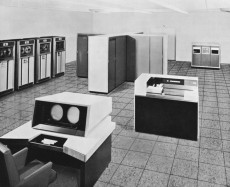NERSC@40: How It All Began
January 30, 2014

The Controlled thermonuclear Research Computer Center--now known as NERSC--was established in 1974 and unveiled its first supercomputer that same year: a Control Data Corporation 6600 "borrowed" from the weapons program at Lawrence Livermore National Laboratory.
In 1974, an almost-obsolete supercomputer once used for defense research was made available to support the fusion energy research community, the first time such a powerful computing resource was used for unclassified scientific computing. That start as the Controlled Thermonuclear Research Computer Center marked the launch of what today is known as the National Energy Research Scientific Computing Center at Lawrence Berkeley National Laboratory (Berkeley Lab).
Located at Lawrence Livermore National Laboratory from 1974-96, the center was renamed the National Magnetic Fusion Energy Computing Center (NMFECC) in 1976, and in 1983 began providing a fraction of its computing cycles to other research areas. To reflect its increasingly broad scientific mission, the center was christened the National Energy Research Supercomputer Center in 1990. The center moved to Berkeley Lab in 1996 and, while keeping the acronym NERSC, was renamed the National Energy Research Scientific Computing Center.
Through the years, NERSC’s mission has remained consistent: to accelerate the pace of scientific discovery by providing high-performance computing, information, data and communications services to the DOE Office of Science community. NERSC supports large-scale, state-of-the-art computing, storage and networking for unclassified research programs in high-energy physics, biological and environmental sciences, basic energy sciences, nuclear physics, fusion energy sciences, mathematics and computational and computer science.
Back in 1974, the Center began operation with a borrowed Control Data Corporation 6600 computer. Initially most users had to connect modems to their terminals and dial up this computer via telephone, though some early users were able to use the ARPA network for connectivity. In 1975, a CDC 7600 replaced the 6600. In 1976, dedicated, leased phone lines connected the Center with the major fusion energy research sites, allowing users to log into the 7600 from their local DEC PDP-10 minicomputers. The machine was rapidly filled to capacity, and for a while we had to purchase additional 7600 time from Berkeley Lab.
The center acquired a Cray 1 in 1978 and soon became known as an innovator in the management and operation of supercomputers. We converted our 7600 operating system, utilities, and libraries to the new machine, creating the Cray Time Sharing System (CTSS) — the first timesharing system for a Cray — and demonstrating that the machine could be used interactively. CTSS was subsequently adopted by nine other computer centers.
The world's first Cray 2, a four-processor system, was installed at the Center in 1985. We had already spent two years preparing the CTSS operating system for multitasking. This preparation paid off when the Cray 2 was available to users only one month after delivery.

In 2013, NERSC installed its fastest supercomputer yet: a Cray XC30 named "Edison."
In 2010, the center broke the trillions-of-calculations-per-second mark with Hopper, a Cray XE6 named for pioneering computing scientist Grace Murray Hopper. With more than 150,000 processor cores, the system is capable of peak theoretical performance of 1.05 Petaflops (trillions of "floating point operations" per second). Hopper joined Franklin, a Cray XT4 accepted in 2009 and retired in 2012, an IBM iDataplex cluster (Carver) and various special-purpose and testbed systems, including PDSF (dedicated to high-energy physics), the Joint Genome Institute's system (Genepool, dedicated to genomic research) and the scientific cloud-computing testbed Magellan (co-located at Argonne National Lab). (Click here for a list of NERSC's computing systems and their technical specs.)
And in 2013 NERSC installed its fastest supercomputer yet: a Cray XC30 named "Edison" in honor of energy pioneer Thomas Alva Edison. The Cray XC30's hybrid water/air cooling system, transverse airflow and high operating temperatures allow NERSC to use the moist, cool air that flows through the Golden Gate from the Pacific Ocean to help reduce cooling costs and increase energy efficiency. Using cooling towers only--without any mechanical refrigeration--Edison can be cooled for one-third the cost of earlier systems.
NERSC currently serves more than 4,700 users from universities, national laboratories and industry worldwide, supporting one of the largest and most diverse research communities of any computing facility. Over its 40-year history, the facility and its staff have developed an outstanding reputation for providing both high-end computing systems and comprehensive scientific client services.
Here’s to another 40 years at the forefront!
About NERSC and Berkeley Lab
The National Energy Research Scientific Computing Center (NERSC) is a U.S. Department of Energy Office of Science User Facility that serves as the primary high performance computing center for scientific research sponsored by the Office of Science. Located at Lawrence Berkeley National Laboratory, NERSC serves almost 10,000 scientists at national laboratories and universities researching a wide range of problems in climate, fusion energy, materials science, physics, chemistry, computational biology, and other disciplines. Berkeley Lab is a DOE national laboratory located in Berkeley, California. It conducts unclassified scientific research and is managed by the University of California for the U.S. Department of Energy. »Learn more about computing sciences at Berkeley Lab.







